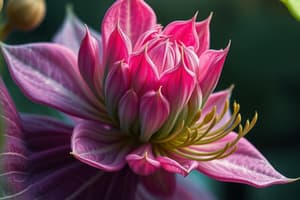Podcast
Questions and Answers
The study of plant ecology involves understanding the impact of climate on plant communities.
The study of plant ecology involves understanding the impact of climate on plant communities.
True (A)
Plant systematics solely relies on morphological data for building phylogenetic trees.
Plant systematics solely relies on morphological data for building phylogenetic trees.
False (B)
The pharmaceutical industry does not benefit from plants in terms of medicinal resources.
The pharmaceutical industry does not benefit from plants in terms of medicinal resources.
False (B)
Symbiotic relationships between plants and organisms, like mycorrhizae, play a vital role in plant ecology.
Symbiotic relationships between plants and organisms, like mycorrhizae, play a vital role in plant ecology.
Understanding plant evolution has no relevance to genetic modifications in agriculture.
Understanding plant evolution has no relevance to genetic modifications in agriculture.
Botany is solely focused on the growth of plants.
Botany is solely focused on the growth of plants.
Roots are responsible for photosynthesis in plants.
Roots are responsible for photosynthesis in plants.
Asexual reproduction in plants can occur through vegetative propagation.
Asexual reproduction in plants can occur through vegetative propagation.
Transpiration refers to the uptake of water by roots.
Transpiration refers to the uptake of water by roots.
Angiosperms are the smallest group of plants based on evolutionary relationships.
Angiosperms are the smallest group of plants based on evolutionary relationships.
Plant hormones are involved in regulating growth and development.
Plant hormones are involved in regulating growth and development.
Ferns are examples of flowering plants.
Ferns are examples of flowering plants.
Leaves are mainly involved in gas exchange in plants.
Leaves are mainly involved in gas exchange in plants.
Flashcards
Plant Ecology
Plant Ecology
The study of how plants interact with their surroundings, including factors like temperature, rainfall, and competition for resources.
Plant Systematics
Plant Systematics
The science of classifying plants based on their evolutionary relationships, using data from morphology, anatomy, and genetics.
Economic Importance of Plants
Economic Importance of Plants
Plants provide essential resources for food, medicine, and industry, including crops, timber, fibers, and medicinal compounds.
Applications of Botany
Applications of Botany
Signup and view all the flashcards
Symbiotic Relationships in Plants
Symbiotic Relationships in Plants
Signup and view all the flashcards
What is Botany?
What is Botany?
Signup and view all the flashcards
What is Photosynthesis?
What is Photosynthesis?
Signup and view all the flashcards
What is Transpiration?
What is Transpiration?
Signup and view all the flashcards
What are plant hormones?
What are plant hormones?
Signup and view all the flashcards
What is Asexual reproduction in plants?
What is Asexual reproduction in plants?
Signup and view all the flashcards
What is Sexual reproduction in plants?
What is Sexual reproduction in plants?
Signup and view all the flashcards
What are Angiosperms?
What are Angiosperms?
Signup and view all the flashcards
What is Plant Physiology?
What is Plant Physiology?
Signup and view all the flashcards
Study Notes
Introduction to Botany
- Botany is the scientific study of plants, encompassing their structure, function, growth, reproduction, evolution, and distribution.
- It covers topics from the microscopic details of plant cells to the global patterns of plant communities.
- Botanists study plant life and their interactions with the environment.
Plant Structure and Morphology
- Plant structures vary, reflecting adaptations to specific environments.
- Key structures include roots, stems, leaves, flowers, and fruits.
- Roots absorb water and nutrients, while stems support and transport resources.
- Leaves are crucial for photosynthesis and gas exchange.
- Flowers are reproductive structures in many flowering plants.
- Fruits develop from flowers and protect seeds.
- Leaf shapes, stem types, and flowering patterns adapt to different climates.
Plant Physiology
- This branch examines the internal workings of plants.
- Photosynthesis converts light energy to chemical energy (sugars).
- Respiration breaks down sugars for energy release.
- Transpiration is water loss through evaporation, driving water uptake.
- Plant hormones regulate growth and development, influencing flowering, leaf formation, and fruit ripening.
Plant Reproduction
- Plants reproduce using various methods.
- Asexual reproduction (e.g., vegetative propagation) creates new plants from parent parts.
- Sexual reproduction (fusion of gametes) results in seeds.
- Flowering plants utilize flowers for reproduction, producing enclosed seeds within fruit.
- Spores are part of the lifecycle of ferns and other non-flowering plants.
Plant Classification and Diversity
- Plants are categorized based on evolutionary relationships.
- Key groups include non-vascular (mosses, liverworts), vascular (ferns, gymnosperms, angiosperms).
- Angiosperms are the most diverse group of plants.
- Identifying species and understanding evolutionary links are central to studying plant diversity.
Plant Ecology
- This area studies plant-environment interactions.
- Plant communities are affected by factors like temperature, rainfall, sunlight, and soil.
- Competition for resources is a key aspect of plant communities.
- Symbiotic relationships (e.g., mycorrhizae, plant-bacteria interactions) are essential.
- Plants play a significant role in ecosystems and climate.
Plant Systematics
- This focuses on the evolutionary relationships between plants.
- Classification aims to illustrate the evolutionary history (phylogeny) of groups.
- Molecular techniques enhance understanding evolutionary relationships.
- Data from morphology, anatomy, and molecular genetics help create phylogenetic trees.
Economic Importance of Plants
- Plants have significant economic value.
- Food production relies on crops (cereals, fruits, vegetables).
- Forests provide timber, fibers, and medicinal compounds.
- Plants are vital to the pharmaceutical industry, providing drug ingredients.
- Industrial products (paper, textiles, oils) derive from plants.
Applications of Botany
- Botanical knowledge has diverse applications.
- Agricultural practices benefit from knowledge of crop improvement.
- Biodiversity conservation requires understanding plant species and their distributions.
- Environmental monitoring uses plants to assess ecological problems.
- Plant evolution research aids genetic modification studies.
Studying That Suits You
Use AI to generate personalized quizzes and flashcards to suit your learning preferences.



